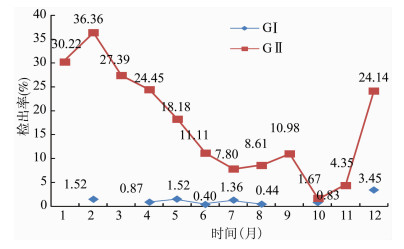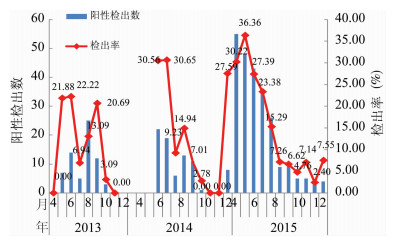扩展功能
文章信息
- 翟前前, 方赤光, 白光大
- ZHAI Qian-qian, FANG Chi-guang, BAI Guang-da
- 2013-2015年吉林省病毒性腹泻监测资料分析
- Surveillance for viral diarrhea in Jilin, 2013-2015
- 疾病监测, 2016, 31(10): 843-846
- Disease Surveillance, 2016, 31(10): 843-846
- 10.3784/j.issn.1003-9961.2016.10.010
-
文章历史
- 收稿日期:2016-04-26
诺如病毒(Norovirus,NV)是引起非细菌性食源性疾病的主要病原体,在全世界范围内均有流行,其感染力极强,在急性非细菌性食源性疾病中,可导致各年龄段人群的散发、暴发和大流行[1-3]。2013年以来,我国其他感染性腹泻病暴发多以诺如病毒感染为主,尤其自2014年冬季起,诺如病毒感染暴发疫情显著增加,高于历年水平[4]。吉林省自2013年起开展诺如病毒感染的食源性疾病监测,对2013-2015年全省疑似病毒性感染所致的食源性疾病进行分析,了解掌握其流行病学特征和趋势,提高对非细菌性食源性疾病疫情的诊断水平和防控能力,以达到控制和降低、减轻该病毒感染所致的食源性疾病负担。
1 资料和方法 1.1 资料来源资料来源于国家食品安全风险评估中心“食源性疾病监测报告系统”中2013-2015年全省19家哨点医院报告的疑似病毒性感染食源性疾病病例。19家哨点医院覆盖全省9市(州)、公主岭市和梅河口市及相关县(市、区)。
1.2 研究对象2013-2015年在全省19家食源性疾病监测哨点医院就诊,且符合食源性疾病病例定义的患者。病例定义:①食源性疾病病例:由食品或怀疑由食品引起的感染性或中毒性的就诊病例。②感染性病例:指有可疑食物暴露史的感染性腹泻病例,临床表现为腹泻,可伴有腹痛、发热、恶心、呕吐等症状的病例。
1.3 检测方法将粪便标本制成10%便悬液,采用瑞士Roche公司的MagNAPureLC Total Nuclcic Acid Isolation Kit提取病毒核酸。采用反转录-聚合酶链反应(reverse transcription-polymerase chain reaction,RT-PCR)检测粪便标本中的诺如病毒。使用美国Invitrogen公司SuperScriptⅢ Reverse Transcripate Kit试剂盒检测GⅠ、GⅡ组诺如病毒核酸。引物GⅠ-SKF序列为CTG CCC GAA TTY GTA AAT GA,GⅠ-SKR序列为CCA ACC CAR CAT TRT ACA;CoG2F序列为CAR GAR BCN ATG TTY AGR TGG ATG AG,G2-SKR序列为CCR CCN GCA TRH CCR TTR TAC AT。
1.4 统计学分析利用Excel 2010软件对病例进行描述性分析,利用SPSS 22.0软件进行χ2检验,P < 0.05为差异有统计学意义。
2 结果 2.1 基本情况共检测2489例疑似病毒性腹泻患者,389例诺如病毒核酸阳性,检出率为15.63%。其中男性1482例,女性1007例,男女性别比例为1.47:1。5岁以下年龄组1259例,所占比例最高,为50.58%。患者以儿童为主,有1353例,占54.36%。
2.2 病原体检测情况389份诺如病毒核酸阳性标本中,16份检出诺如病毒GⅠ组,371份标本检出GⅡ组,2份标本同时检出GⅠ组和GⅡ组,GⅠ组检出率为0.72%(18/2489),GⅡ组检出率为14.99%(373/2489),远高于GⅠ组检出率,差异有统计学意义(χ2=349.789,P=0.000),GⅠ组和GⅡ组检出阳性的时间分布见图 1。

|
| 图 1 2013-2015年吉林省各月份病毒性腹泻病例GⅠ、GⅡ诺如病毒检出率 Figure 1 Monthly detections of norovirus GⅠand GⅡ in viral diarrhea cases in Jilin, 2013-2015 |
| |
对诺如病毒检出率进行Pearson χ2检验,自2013年起诺如病毒检出率呈逐年上升趋势(2013年12.18%、2014年14.84%和2015年17.26%)(χ2=7.986,P=0.018),对同年份之间检出率进行比较,2015年检出率显著高于2013年(χ2=7.578,P=0.03);Pearson χ2检验结果显示,第一~四季度诺如病毒检出率呈下降趋势,依次为31.00%、18.66%、9.43%和4.99%,各季度诺如病毒检出率之间差异有统计学意义(χ2=147.142,P=0.000);经分析监测月份检出率后发现,各月份之间检出率差异均有统计学意义,总体呈现12月至次年2月上升,2-11月下降的趋势,12月至次年5月诺如病毒的检出率高于其他月份;不同性别间诺如病毒检出率差异无统计学意义(χ2=0.145,P=0.374),不同年龄组间诺如病毒检出率差异有统计学意义(χ2=29.635,P=0.001),85岁以上(22.73%)和5岁以下(18.90%)年龄组诺如病毒检出率高于其他年龄组;各职业组间比较,不同职业检出率差异有统计学意义(χ2=24.005,P=0.004);不同居住环境,城市和农村诺如病毒检出率间差异无统计学意义(χ2=1.542,P=0.122),从11个地区的检出情况分析来看,长春地区检出率(34.06%)显著高于其他地区(χ2=159.204,P=0.000)见图 2,表 1~3。

|
| 图 2 2013-2015年吉林省各月份病毒性腹泻病例诺如病毒检出情况 Figure 2 Monthly detections of norovirus in viral diarrhea cases in Jilin, 2013-2015 |
| |
| 年龄组(岁) | 监测人数 | 检出例数 | 检出率 (%) |
χ2值 | P值 |
| <5 | 1259 | 238 | 18.90 | ||
| 5~ | 151 | 11 | 7.28 | ||
| 15~ | 97 | 14 | 14.43 | ||
| 25~ | 203 | 30 | 14.78 | ||
| 35~ | 116 | 15 | 12.93 | 29.635 | 0.001 |
| 45~ | 183 | 20 | 10.93 | ||
| 55~ | 229 | 34 | 14.85 | ||
| 65~ | 139 | 12 | 8.63 | ||
| 75~ | 90 | 10 | 11.11 | ||
| ≥85 | 22 | 5 | 22.73 |
| 职业 | 监测人数 | 检出例数 | 检出率 (%) |
χ2值 | P值 |
| 儿童 | 1353 | 245 | 18.11 | ||
| 学生 | 127 | 13 | 10.24 | ||
| 医生、教师、职员 | 152 | 22 | 14.47 | ||
| 工人、农民、民工 | 150 | 19 | 12.67 | ||
| 商业服务 | 9 | 4 | 44.44 | 24.005 | 0.004 |
| 餐饮食品业 | 11 | 1 | 9.09 | ||
| 家务及待业 | 231 | 24 | 10.39 | ||
| 离退人员 | 166 | 19 | 11.45 | ||
| 其他 | 281 | 40 | 14.23 | ||
| 不详 | 9 | 2 | 22.22 |
| 地区 | 监测人数 | 检出人数 | 检出率 (%) |
χ2值 | P值 |
| 长春市 | 323 | 110 | 34.06 | ||
| 吉林市 | 270 | 37 | 13.70 | ||
| 延边朝鲜族自治州 | 334 | 71 | 21.26 | ||
| 四平市 | 218 | 37 | 16.97 | ||
| 通化市 | 204 | 31 | 15.20 | ||
| 白城市 | 311 | 48 | 15.43 | 159.204 | 0.000 |
| 辽源市 | 265 | 2 | 0.75 | ||
| 松原市 | 221 | 25 | 11.31 | ||
| 白山市 | 235 | 16 | 6.81 | ||
| 公主岭市 | 51 | 2 | 3.92 | ||
| 梅河口市 | 57 | 10 | 17.54 |
2013-2015年吉林省食源性疾病中诺如病毒的检出率呈逐年上升趋势,2015年为15.63%,显著高于2013年的检出率,其中2013-2015年5岁以下婴幼儿的检出率为18.9%,远高于2011年的13.6%[5],略高于2012-2013年的18.1%[6]。中国疾病预防控制中心报告2013年以来我国诺如病毒感染暴发疫情大幅增加,显著高于历年水平[4],诺如病毒感染在吉林省呈上升趋势,但吉林省近5年检出率均低于2012年广东省的22.14%和2009年全国的25.90%[7-8]。
分析表明,2013年以来,吉林省诺如病毒检出率逐年升高,2015年最高。诺如病毒第一、二季度的检出率高于第三、四季度,每年12月到次年5月诺如病毒的检出率高于其他月份,符合诺如病毒在寒冷季节流行的特征[9]。吉林省位于我国东北地区,初春(3月)气温回升较快,而在春季后期(4月或5月)气温较正常年份偏低,因此在4-5月诺如病毒的检出率仍然较高。
诺如病毒患者男性多于女性,性别间检出率差异无统计学意义。主要感染患者为85岁以上(22.73%)和5岁以下(18.90%)年龄组,职业分布中,商业服务占44.44%、儿童占18.11%,这与世界卫生组织报告中,食源性疾病在儿童、孕妇、老年人和免疫系统弱的人身上更严重,5岁以下儿童占食源性疾病负担的40%相一致[10]。从事商业服务的人员,由于其就餐的复杂性,其诺如病毒的检出率较高。本研究中,5岁以下年龄组和儿童的诺如病毒检出率高于Medici等[3]在对儿科患者散发感染诺如病毒监测中的检出率。
城市和农村的居住环境不同,居民诺如病毒检出率之间差异无统计学意义,这与吉林省历年的城乡食源性疾病感染无差异的情况相同[11-12]。不同地区诺如病毒检出率差异有统计学意义,长春市明显高于其他地区。其辖区内有三家哨点医院,并且一家为儿童专科医院,儿童诺如病毒检出率高于其他年龄组,可能对这个地区的检出率有一定影响。
2013-2015年吉林省主要流行的诺如病毒基因为GⅡ组,GⅠ组在少数患者中有检出,极少数患者中同时检出诺如病毒GⅠ组和GⅡ组,从各月份检出率来看,GⅠ组检出率也明显低于GⅡ组。长期以来,全球范围内诺如病毒GⅡ组的流行明显超过GⅠ组,在我国亦是如此,甚至在某些省份,例如GⅡ组病毒是引起广东省诺如病毒暴发的唯一病毒[13]。
近年来诺如病毒在全国暴发疫情大幅增加,也成为吉林省主要流行的病原体,尤其是对5岁以下儿童的健康造成巨大影响,因此应将诺如病毒的监测纳入单病种监测范围。并且重点监测儿童、孕妇、老年人和免疫系统弱的人群,加大防控力度,提高监测水平。
作者贡献:翟前前:监测数据搜集、报告和数据分析,质量控制,稿件撰写
方赤光、白光大:监测方案设计,总体构思,稿件审核
| [1] | Vinjé J, Green J, Lewis DC, et al. Genetic polymorphism across regions of the three open reading frames of "Norwalk-like viruses"[J]. Arch Virol , 2000, 145 (2) : 223–241. DOI:10.1007/s007050050020 |
| [2] | Iritani N, Seto Y, Kubo H, et al. Prevalence of Norwalk-like virus infections in cases of viral gastroenteritis among children in Osaka city, Japan[J]. J Clin Microbiol , 2003, 41 (4) : 1756–1759. DOI:10.1128/JCM.41.4.1756-1759.2003 |
| [3] | Medici MC, Martinelli M, Abelli LA, et al. Molecular epidemiology of norovirus infections in sporadic cases of viral gastroenteritis among children in Northern Italy[J]. J Med Virol , 2006, 78 (11) : 1486–1492. DOI:10.1002/(ISSN)1096-9071 |
| [4] | China CDC. Guidelines on outbreak investigation, prevention and control of norovirus infection (2015)[R]. Beijing:China CDC, 2015. (in Chinese) 中国疾病预防控制中心.诺如病毒感染暴发调查和预防控制技术指南(2015版)[R].北京:中国疾病预防控制中心, 2015. http://cqvip.com/qk/92392X/201601/667798327.html |
| [5] | Li X, Yang XD, Xu S, et al. Epidemiological Characteristics and Genotype of Norovirus in Infants under 5 Years Old in Jilin province in 2011[J]. Chinese Journal of Vaccines and Immunization , 2013 (5) : 431–434. (in Chinese) 李响, 杨显达, 许爽, 等. 吉林省2011年 < 5岁婴幼儿诺如病毒感染流行病学特征及基因型研究[J]. 中国疫苗和免疫 , 2013 (5) : 431–434. |
| [6] | Li X, Yang XD, Xu S, et al. Detection of Norovirus Genotype GⅡ. 4 Sydney 2012 Variant from Children under 5 Years of Age in Jilin province, 2012-2013[J]. Chinese Journal of Vaccines and Immunization , 2015 (3) : 283–288. (in Chinese) 李响, 杨显达, 许爽, 等. 吉林省2012-2013年 < 5岁婴幼儿中检出诺如病毒GⅡ.4 Sydney(悉尼)2012变异株[J]. 中国疫苗和免疫 , 2015 (3) : 283–288. |
| [7] | Deng AP, Sun LM, Mo YL, et al. Etiological characteristics of viral diarrhea in Guangdong province, 2012[J]. South China Journal of Preventive Medicine , 2014, 40 (2) : 119–122. (in Chinese) 邓爱萍, 孙立梅, 莫艳玲, 等. 广东省2012年病毒性腹泻病原学特征分析[J]. 华南预防医学 , 2014, 40 (2) : 119–122. |
| [8] | Zeng M, Xu XH, Zhu CM, et al. Clinical and molecular epidemiology of norovirus infection in childhood diarrhea in China[J]. J Med Virol , 2012, 84 (1) : 145–151. DOI:10.1002/jmv.v84.1 |
| [9] | Ahmed SM, Lopman BA, Levy K. A systematic review and meta-analysis of the global seasonality of norovirus[J]. PLoS One , 2013, 8 (10) : e75922. DOI:10.1371/journal.pone.0075922 |
| [10] | World Health Organization. WHO estimates of the global burden of foodborne diseases[R]. Geneva:World Health Organization, 2015. |
| [11] | Zhang D, Zhai QQ, Weng XJ, et al. Analysis of food poisoning emergency public health events in Jilin province, 2004-2013[J]. Chinese Journal of Food Hygiene , 2015, 27 (6) : 619–623. (in Chinese) 张迪, 翟前前, 翁熹君, 等. 2004-2013年吉林省食物中毒突发公共卫生事件流行病学分析[J]. 中国食品卫生杂志 , 2015, 27 (6) : 619–623. |
| [12] | Xing Y, Bai GD, Liu L, et al. Incidence and associated factors of foodborne diarrhea among residents in Jilin province, 2012-2013[J]. Chinese Journal of Public Health , 2015, 31 (4) : 488–490. (in Chinese) 邢扬, 白光大, 刘璐, 等. 吉林省2012-2013年食源性腹泻患病情况及影响因素分析[J]. 中国公共卫生 , 2015, 31 (4) : 488–490. |
| [13] | Li H, Mo YL, Ke CW, et al. Molecular epidemiological characteristics of norovirus gastroenteritis outbreaks in Guangdong from 2005 to 2008[J]. Chinese Journal of Virology , 2010, 26 (3) : 202–207. (in Chinese) 李晖, 莫艳玲, 柯昌文, 等. 2005-2008年广东省诺如病毒胃肠炎暴发的分子流行病学特征[J]. 病毒学报 , 2010, 26 (3) : 202–207. |
 2016, Vol. 31
2016, Vol. 31


